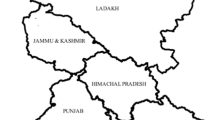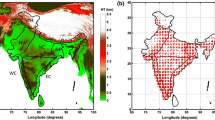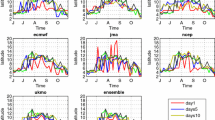Abstract
The seasonal scale precipitation amount is an important ingredient in planning most of the agricultural practices (such as a type of crops, and showing and harvesting schedules). India being an agroeconomic country, the seasonal scale prediction of precipitation is directly linked to the socioeconomic growth of the nation. At present, seasonal precipitation prediction at regional scale is a challenging task for the scientific community. In the present study, an attempt is made to develop multi-model dynamical-statistical approach for seasonal precipitation prediction at the regional scale (meteorological subdivisions) over India for four prominent seasons which are winter (from December to February; DJF), pre-monsoon (from March to May; MAM), summer monsoon (from June to September; JJAS), and post-monsoon (from October to December; OND). The present prediction approach is referred as extended range forecast system (ERFS). For this purpose, precipitation predictions from ten general circulation models (GCMs) are used along with the India Meteorological Department (IMD) rainfall analysis data from 1982 to 2008 for evaluation of the performance of the GCMs, bias correction of the model results, and development of the ERFS. An extensive evaluation of the performance of the ERFS is carried out with dependent data (1982–2008) as well as independent predictions for the period 2009–2014. In general, the skill of the ERFS is reasonably better and consistent for all the seasons and different regions over India as compared to the GCMs and their simple mean. The GCM products failed to explain the extreme precipitation years, whereas the bias-corrected GCM mean and the ERFS improved the prediction and well represented the extremes in the hindcast period. The peak intensity, as well as regions of maximum precipitation, is better represented by the ERFS than the individual GCMs. The study highlights the improvement of forecast skill of the ERFS over 34 meteorological subdivisions as well as India as a whole during all the four seasons.











Similar content being viewed by others
References
Acharya N, Kar SC, Kulkarni MA, Mohanty UC, Sahoo LN (2011) Multi-model ensemble schemes for predicting northeast monsoon rainfall over peninsular India. J Earth Syst Sci 120(5):795–805
Acharya N, Chattopadhyay S, Mohanty UC, Dash SK, Sahoo LN (2012) On the bias correction of general circulation model output for Indian summer monsoon. Meteorol Appl 20:349–356. https://doi.org/10.1002/met.1294
Acharya N, Singh A, Mohanty UC, Nair A, Chattopadhyay S (2013) Performance of general circulation models and their ensembles for the prediction of drought indices over India during summer monsoon. Nat Hazards 66(2):851–871. https://doi.org/10.1007/s11069-012-0531-8
Barnston AG, Smith TM (1996) Specification and prediction of global surface temperature and precipitation from global SST using CCA. J Clim 9:2660–2697
Collins WD et al (2006) The community climate system model version 3 (CCSM3). J Clim 19:2122–2143
Dash SK, Kulkarni MA, Mohanty UC, Prasad K (2009) Changes in the characteristics of rain events in India. J Geophys Res 114:D10109. https://doi.org/10.1029/2008JD010572
Dhekale BS, Nageswararao MM, Nair A, Mohanty UC, Swain DK, Singh KK, Arunbabu T (2017) Prediction of kharif rice yield at Kharagpur using disaggregated extended range rainfall forecasts. Theor Appl Climatol. https://doi.org/10.1007/s00704-017-2232-4
Dimri AP, Niyogi D, Barros AP, Ridley J, Mohanty UC, Yasunari T, Sikka DR (2015) Western disturbances: a review. Rev Geophys. https://doi.org/10.1002/2014RG000460
Doblas-Reyes FJ, Deque M, Piedelievre JP (2000) Multi-model spread and probabilistic seasonal forecasts in PROVOST. Q J R Meteorol Soc 126:2069–2088. https://doi.org/10.1002/qj.49712656705
Fekedulegn BD, Colbert JJ, Hicks RR, Schuckers M (2002) Co** with multicollinearity: an example on application of principal components regression in dendroecology. Newton Square, PA, Department of Agriculture, Forest Service, Northeastern Research Station
Gadgil S, Sajani S (1998) Monsoon precipitation in the AMIP runs. Clim Dyn 14(9):659–689
Ghosh K, Ankita S, Mohanty UC, Nachiketa A, Pal RK, Singh KK, Pasupalak S (2014) Development of a rice yield prediction system over Bhubaneswar, India: combination of extended range forecast and CERES-rice model. Meteorol Appl. https://doi.org/10.1002/met.1483
Goddard L, Barnston AG, Mason SJ (2003) Evaluation of the IRI’s “net assessment” seasonal climate forecasts: 1997–2001. Bull Am Meteorol Soc 84(12):1761–1781. https://doi.org/10.1175/BAMS-84-12-1761
Goswami BN, Venugopal V, Sengupta D, Madhusoodanan MS, Xavier PK (2006) Increasing trend of extreme rain events over India in a warming environment. Science 314:1442–1445. https://doi.org/10.1126/science.1132027
Gowariker VV, Thapliyal RP, Sarker GS, Mandal SDR (1989) Parametric and power regression models: new approach to long range forecasting of monsoon rainfall in India. Mausam 40:115–122
Graham NE, Michaelsen J, Barnett TP (1987) An investigation of the El Nino–Southern Oscillation cycle with statistical models. Part 1. Predictor field characteristics. J Geophys Res 92:14,251–14,270
Hurrell JW, Hack JJ, Boville BA, Williamson DL, Kiehl JT (1998) The dynamical simulation of the NCAR Community Climate Model version 3 (CCM3). J Clim 11:1207–1236. https://doi.org/10.1175/1520-0442(1998)011<1207:TDSOTN>2.0.CO;2
Kar SC, Rana S (2014) Interannual variability of winter precipitation over northwest India and adjoining region: impact of global forcings. Theor Appl Climatol 116(3-4):609–623. https://doi.org/10.1007/s00704-013-0968-z
Kar SC, Hovsepyan A, Park CK (2006) Economic values of the APCN multi-model ensemble categorical seasonal predictions. Meteorol Appl 13(3):267–277. https://doi.org/10.1017/S1350482706002271
Kar SC, Acharya N, Mohanty UC, Kulkarni MA (2011) Skill of monthly rainfall forecasts over India using multi-model ensemble schemes. Int J Climatol 32:1271–1286. https://doi.org/10.1002/joc.2334
Kekane MA (2013) Indian agriculture—status, importance and role in Indian economy. Int J Agric Food Sci Technol 4(4):343–346
Kharin VV, Zwiers FW (2003) Improved seasonal probability forecasts. J Clim 16:1684–1701. https://doi.org/10.1175/1520-0442(2003)016<1684:ISPF>2.0.CO;2
Kiran Prasad S, Mohanty UC, Routray A, Osuri KK, Ramakrishna SSVS, Niyogi D (2014) Impact of Doppler weather radar data on thunderstorm simulation during STORM pilot phase—2009. Nat Hazards 74(3):1403–1427. https://doi.org/10.1007/s11069-014-1250-0
Kirtman BP et al (2014) The North American multimodel ensemble: phase-1 seasonal-to-interannual prediction; phase-2 toward develo** intraseasonal prediction. Bull Am Meteorol Soc 95:585–601. https://doi.org/10.1175/BAMS-D-12-00050.1
Krishna Kumar K, Martin H, Balaji R (2005) Advancing dynamical prediction of Indian monsoon rainfall. Geophys Res Lett 32(8):L08704. https://doi.org/10.1029/2004GL021979
Krishnamurti TN, Kishtawal CM, Shin DW, Williford CE (2000) Multimodel superensemble forecasts for weather and seasonal climate. J Clim 13:4196–4216. https://doi.org/10.1175/1520-0442(2000)013<4196:MEFFWA>2.0.CO;2
Kulkarni MA, Singh A, Mohanty UC (2012) Effect of spatial correlation on regional trends in rain events over India. Theor Appl Climatol 107:441–450. https://doi.org/10.1007/s00704-012-0602-5
Magnusson L, Kallen (2013) Factors influencing skill improvements in the ECMWF forecasting system. Mon Weather Rev 141:3142–3153. https://doi.org/10.1175/MWR-D-12-00318.1
Min YM, Vladimir NK, Sang MO (2014) Assessment of APCC multimodel ensemble prediction in seasonal climate forecasting: retrospective (1983–2003) and real-time forecasts (2008–2013). J Geophys Res Atmos 119:12132–12150. https://doi.org/10.1002/2014JD022230
Mohanty UC et al (2013) Real-time experimental extended range forecast systemfor Indian southwestmonsoon rainfall: a case study for monsoon 2011. Curr Sci 104(7):856–870
Molteni F, Stockdale T, Balmaseda M, Balsamo G, Buizza R, Ferranti L, Magnusson L, Mogensen K, Palmer T, Vitart F (2011) The new ECMWF seasonal forecast system (System 4). ECMWF Tech Memorandum 656
Nageswararao MM, Mohanty UC, Ramakrishna SSVS, Nair A, Kiran Prasad S (2016a) Characteristics of winter precipitation over Northwest India using high-resolution gridded dataset (1901–2013). Glob Planet Chang 147:67–85. https://doi.org/10.1016/j.gloplacha.2016.10.017
Nageswararao MM, Dhekale BS,Mohanty UC (2016b) Impact of climate variability on various Rabi crops over Northwest India. Theor Appl Climatol https://doi.org/10.1007/s00704-016-1991-7
Nageswararao MM, Mohanty UC, Osuri KK, Ramakrishna SSVS (2016c) Prediction of winter precipitation over northwest India using ocean heat fluxes. Clim Dyn 47(7):2253–2271. https://doi.org/10.1007/s00382-015-2962-x
Nageswararao MM, Mohanty UC, Kiran Prasad S, Osuri KK, Ramakrishna SSVS (2016d) Performance evaluation of NCEP climate forecast system for the prediction of winter temperatures over India. Theor Appl Climatol 126(3):437–451. https://doi.org/10.1007/s00704-015-1588-6
Nageswararao MM, Mohanty UC, Nair A, Ramakrishna SSVS (2016e) Comparative evaluation of performances of two versions of NCEP climate forecast system in predicting winter precipitation over India. Pure Appl Geophys 173(6):2147–2166. https://doi.org/10.1007/s00024-015-1219-2
Nageswararao MM, Mohanty UC, Dimri AP, Krishna K, Osuri (2017) Probability of occurrence of monthly and seasonal winterprecipitation over Northwest India based on antecedent-monthlyprecipitation. Theor Appl Climatol. https://doi.org/10.1007/s00704-017-2171-0
Nair A, Mohanty UC, Acharya N (2012) Monthly prediction of rainfall over India and its homogeneous zone: a supervised principalcomponent regression approach on global climate models. Theor Appl Climatol. https://doi.org/10.1007/s00704-012-0660-8
Nair A, Acharya N, Ankita S, Mohanty UC, Panda TC (2013) On the predictability of northeast monsoon rainfall over South Peninsular India in general circulation models. Pure Appl Geophys 170(11):1945–1967. https://doi.org/10.1007/s00024-012-0633-y
Nair A, Mohanty UC, Robertson AW, Panda TC, Luo JJ, Yamagata T (2014) An analytical study of hindcasts from general circulation models for Indian summer monsoon rainfall. Meteorol Appl 21:695–707. https://doi.org/10.1002/met.1395
Naiyer A, Sarfraz Ul Haque M (2015) Agriculture play crucial role in the life of Indian economy. Int J Sci Res Manag 3(3):2239–2245
Navone HP, Ceccato HA (1995) Predicting Indian monsoon rainfall: a neural network approach. Clim Dyn 10:305–312. https://doi.org/10.1007/BF00228029
Pai DS, Bhan SC (2014) Monsoon 2013—a report IMD Met monograph: Synoptic Meteorology No. ESSO/IMD/SYNOPTIC MET/01-2014/15, 1-17.
Palmer TN et al (2004) Development of a European multimodel ensemble system for seasonal to interannual prediction (DEMETER). Bull Am Meteorol Soc 85:853–872
Preethi B, Revadekar JV (2013) Kharif food grain yield and daily summer monsoon precipitation over India. Int J Climatol 33:1978–1986
Preethi B, Kripalani RH, Kumar KK (2010) Indian summer monsoon rainfall variability in global coupled ocean–atmospheric models. Climate Dyn 35:1521–1539. https://doi.org/10.1007/s00382-009-0657-x
Preethi B, Mujumdar M, Kripalani RH, Amita P, Krishnan R (2017) Recent trends and teleconnections among South and East Asian summer monsoons in a warming environment. Clim Dyn 48:2489–2505. https://doi.org/10.1007/s00382-016-3218-0
Rajeevan M, Bhate J, Kale J, Lal B (2006) High resolution daily gridded rainfall data for the Indian region: analysis of break and active monsoon spells. Curr Sci 91:296–306
Rajeevan M, Pai DS, Kumar RA, Lal B (2007) New statistical models for long-range forecasting of southwest monsoon rainfall over India. Climate Dynamics, 28(7-8): 813-828, https://doi.org/10.1007/s00382-006-0197-6
Rajeevan M, Unnikrishnan CK, Preethi B (2012) Evaluation of the ENSEMBLES multi-model seasonal forecasts of Indian summer monsoon variability. Clim Dyn 38:2257–2274. https://doi.org/10.1007/s00382-011-1061-x
Ramanathan V, Chung C, Kim D, Bettge T, Buja L, Kiehl JT et al (2005) Atmospheric brown clouds: impacts on South Asian climate and hydrological cycle. Proc Natl Acad Sci U S A 102:5326–5333
Ramesh KV, Goswami P (2007) Reduction in temporal and spatial extent of the Indian southwest monsoon. Geophys Res Lett 34:L23704
Revadekar JV, Preethi B (2012) Statistical analysis of the relationship between summer monsoon precipitation extremes and foodgrain yield over India. Int J Climatol 32:419–429
Roeckner E, Arpe K, Bengtsson L, Christoph M, Claussen M, Dümenil L, Esch M, Giorgetta M, Schlese U, Schulzweida U (1996) The atmospheric general circulation model ECHAM4: model description and simulation of present-day climate. Max-Planck- Institut fur Meteorologie Rep. 218: Hamburg, Germany; p. 90
Saha S, Nadiga S, Thiaw C, Wang J, Wang W, Zhang Q, Van Den Dool HM, Pan H-L, Moorthi S, Behringer D, Stokes D, Pena M, Lord S, White G, Ebisuzaki W, Peng P, **e P (2006) The NCEP climate forecast system. J Clim 19(15):3483–3517. https://doi.org/10.1175/JCLI3812.13812.1
Saha S, Moorthi S, Wu X, Wang J, Nadiga S, Tripp P, Behringer D, Hou Y-T, Chuang H-Y, Iredell M, Ek M, Meng J, Yang R, Mendez RP, HVD D, Zhang Q, Wang W, Chen M, Becker E (2014) The NCEP climate forecast system version 2. J Clim 27:2185–2208. https://doi.org/10.1175/JCLI-D-12-00823.1
Singh A, Kulkarni MA, Mohanty UC, Kar SC, Robertson AW, Mishra G (2012) Prediction of Indian southwest monsoon rainfall using canonical correlation analysis of global circulation model products. Meteorol Appl 19(2):179–188. https://doi.org/10.1002/met.1333
Sinha P, Mohanty UC, Kar SC, Dash SK, Robertson A, Tippett M (2013) Seasonal prediction of the Indian summer monsoon rainfall using canonical correlation analysis of the NCMRWF global model products. Int J Climatol 33:1601–1614. https://doi.org/10.1002/joc.3536
Sinha P, Tiwari PR, Kar SC, Mohanty UC, Raju PVS, Dey S, Sekhar MS (2015) Sensitivity studies of convective schemes and model resolutions in simulations of wintertime circulation and precipitation over the Western Himalayas. Pure Appl Geophys 172:503–530. https://doi.org/10.1007/s00024-014-0935-3
Stephenson DB, Doblas-Reyes FJ (2000) Statistical methods for interpreting Monte Carlo ensemble forecasts. Tellus 52:300–322
Thapliyal V (1982) Stochastic dynamic model for long range prediction of monsoon rainfall in peninsular India. Mausam 33:399–404
Tiwari PR, Kar SC, Mohanty UC, Kumari S, Sinha P, Nair A, Dey S (2014) Skill of precipitation prediction with GCMs over north India during winter season. Int J Clim 34(12):3440–3455. https://doi.org/10.1002/joc.3921
Tiwari PR, Kar SC, Mohanty UC, Dey S, Sinha P, Raju PVS, Shekhar MS (2016) On the dynamical downscaling and bias correction of seasonal-scale winter precipitation predictions over North India. Q J R Meteorol Soc. https://doi.org/10.1002/qj.2832
Walker GT (1910) Correlation in seasonal variation of weather II. Memoirs of India
Wang B, Ding Q, Fu X, Kang I, ** K, Shukla J, Doblas-Reyes F (2005) Fundamental challenge in simulation and prediction of summer monsoon rainfall. Geophys Res Lett. https://doi.org/10.1029/2005GL022734
Wilks DS (1995) Statistical methods in atmospheric sciences, vol 59, 2nd edn. Academic Press, San Diego, 467 p
Yadav RK, Rupa Kumar K, Rajeevan M (2012) Characteristic features of winter precipitation and its variability over northwest India. J Earth Syst Sci 121(3):611–623
Yu Z, Chu PS, Schroeder T (1997) Predictive skills of seasonal to annual rainfall variations in the U.S. Affiliated Pacific Islands: canonical correlation analysis and multivariate principal component regression approaches. J Clim 10:2586–2599
Yun W-T, Stefanova L, Krishnamurti TN (2003) Improvement of the superensemble technique for seasonal forecasts. J Clim 16:3834–3840
Acknowledgements
This research has been sponsored by the Department of Agriculture, Cooperation & Farmers Welfare (DAC & FW), Minstry of Agriculture & Farmers Welfare, Government of India, and duly acknowledged. The authors gratefully acknowledge the India Meteorological Department for providing the gridded precipitation dataset. We also thank the International Research Institute for climate and Society (IRI), Columbia University and National Centres for Environmental Prediction (NCEP) for providing GCMs output in hindcast and real-time mode. Dr. N. Acharya, Dr. K. Prasad, Dr. M. A. Kulkarni, Prof. S. K Dash, Dr. D. R. Pattnaik and Mr. Itesh Dash are acknowledged for providing their expertise in various stages of this study. We are very much thankful to the anonymous reviewers for providing valuable suggestions and comments which are helpful in the improvement of the quality of the manuscript.
Author information
Authors and Affiliations
Corresponding author
Appendix
Appendix
Rights and permissions
About this article
Cite this article
Mohanty, U.C., Nageswararao, M.M., Sinha, P. et al. Evaluation of performance of seasonal precipitation prediction at regional scale over India. Theor Appl Climatol 135, 1123–1142 (2019). https://doi.org/10.1007/s00704-018-2421-9
Received:
Accepted:
Published:
Issue Date:
DOI: https://doi.org/10.1007/s00704-018-2421-9




